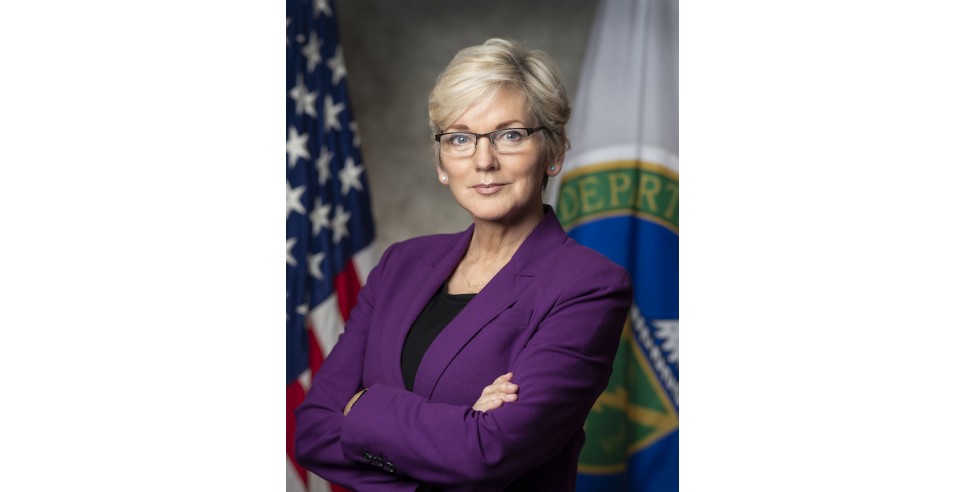
Long-term career staffers in the federal government have seen presidential administrations come and go, but if ever a transition between one administration and the next has caused whiplash, it may well be the one that transpired in January of this year. The Department of Energy is one Cabinet-level agency in particular where many of the stated priorities have flipped 180 degrees between the Trump and Biden administrations.
Donald Trump called climate change a hoax invented by China. He summarily pulled the United States out of the Paris Agreement, a legally binding international treaty that had been adopted by 196 parties to combat climate change. Trump focused his energy agenda on America’s oil, gas and coal industries – even though it is the burning of these fossil fuels, unfortunately, that scientists say is the dominant cause of global warming.
His successor, on the other hand, believes in the urgent need to address climate change. On his first full day in the Oval Office, Joe Biden made a point of rejoining the Paris climate accord. Among other early actions concerning energy and the environment, Biden also announced ambitious goals for cutting greenhouse gas emissions by half in the next ten years. And he chose former Michigan governor Jennifer Granholm to head the Department of Energy.
Granholm had already established a track record in clean energy. She’d turned adversity into advantage when the Great Lake State faced tough times during the 2008 global financial crisis. Detroit’s automakers were about to turn belly-up, but Granholm worked with the Obama administration to support the auto industry and propelled her state into becoming a leader in EV manufacture by expanding incentives for carmakers to develop batteries for electric vehicles. As Governor, she also backed incentives for wind and solar projects and signed a bill that ensured that Michigan would draw at least 10 percent of its energy from renewable resources.
Since Granholm has taken charge at the DOE, she’s been focused on three priorities: combating the climate crisis, creating clean energy union jobs, and promoting energy justice. This latter goal aims to deliver 40 percent of the overall benefits of climate investments to low-income communities and communities of color that historically have been most subjected to polluting industries.
To address the climate crisis, Granholm been hosting clean energy summits modeled after the ambitious moonshot program that led to landing Americans on the moon in 1969. The DOE’s Energy Earthshots Initiative focuses on bringing together key players to figure out how to accelerate breakthroughs in “linchpin” technologies in the quest for clean energy. A Hydrogen Shot Summit took place at the end of August, and committed to a goal of reducing the cost of clean hydrogen by 80 percent within the next decade. The Long Duration Storage Shot happened a few weeks later, and set a target of reducing the cost of grid-scale energy storage by 90% – also within the next decade. The DOE plans to hold half a dozen more Energy Earthshots over the next year.
And by investing in these promising technologies and cultivating public-private partnerships, the Biden administration expects to develop clean energy industries that will support well-paying union jobs, as well as reverse the harmful effects of human activity on our climate.
---
These 21st century imperatives were scarcely a gleam in the eye when the Department of Energy was created in 1977 in response to a series of energy crises. This was happening during a decade of rising oil consumption in America and other countries in the Western world, while domestic oil production was waning. At the same time, tensions in the Middle East led to crippling embargos by oil exporting nations. Presidents Nixon, Ford and Carter all had suffered through these events, and recognized the need for a more cohesive approach toward energy policy.
As a new Cabinet-level department established during President Jimmy Carter’s administration, the DOE was assigned a portfolio of various fuel- and energy-related programs that had arisen at various times over the past century and previously were scattered throughout the Federal government. The DOE developed a framework that coordinated all of those federal agency functions. It centralized energy data collection and analysis, developed energy regulatory programs, and marketed federal power. The Department also became responsible for promoting energy conservation programs, and for funding long-term research and development of energy technology.
And finally, the DOE assumed oversight of America’s nuclear capabilities.
The United States had gotten involved in nuclear weapons development during World War II. (To put this in perspective, remember that only 50 years earlier, Americans were marveling at the invention of electric light bulbs at Chicago’s Columbian Exposition.) The Manhattan Project tapped some of America’s most brilliant minds in a secretive effort to build a nuclear bomb that would defeat the enemy. Following the successful – and horrifically deadly – detonation of those weapons, Americans reacted with a combination of relief to see the war come to an end, but misgivings about the destruction that had been unleashed. President Harry Truman, who had authorized dropping the bombs over Hiroshima and Nagasaki, vowed to safeguard the technical processes of production until further intensive research might demonstrate “how atomic power can become a powerful and forceful influence towards the maintenance of world peace.”
But in 1949, the Soviet Union exploded its own nuclear device, and the arms race was underway. The U.S. became deeply involved in the design, construction and testing of nuclear weapons. Decades of Cold War gamesmanship followed. As the United States and Soviet Union manufactured and stockpiled increasingly lethal weapons designed to obliterate entire cities, and other nations eventually followed suit, schoolchildren were drilled pointlessly to take cover under their desks in the event of nuclear attack.
In 1972, the bilateral Strategic Arms Limitation Treaty and Anti-Ballistic Missile Treaty signed by the United States and the Soviet Union was a first attempt to curb the Mutually Assured Destruction madness of the nuclear arms race. But it wasn’t until 1991, when President George H.W. Bush and the Soviet Union’s Mikhail Gorbachev signed the Strategic Arms Reduction Treaty, that dismantling of the nuclear arsenal began in earnest and signaled the end of the Cold War. There was plenty of dismantling to do: at that point the U.S. had some 22,000 nuclear warheads in its arsenal; the Soviet Union (soon to break apart) had 35,000.
---
Donald Trump had never held public office before running for President in 2016 and winning the electoral, but not the popular vote. Before he ever saw the inside of the Oval Office, President–elect Trump flaunted his signature bluster in suggesting that, despite the previous quarter century of gradual nuclear disarmament, reigniting a nuclear arms race would be a good idea.
“Let there be an arms race!” he told MSNBC’s Mika Brzezinski. “Because we will outmatch them at every pass and outlast them all!”
Trump’s boastful temperament, his mixed messages, and his clear disinterest in listening to experts characterized the nuclear policies emanating from the White House throughout his term in office. His withdrawal from the nuclear agreement with Iran left American allies shaking their heads, as the move enabled Iran to get back into the uranium enrichment business – and closer to having the ability to manufacture its own nuclear weapon. Elsewhere in the world, Trump rewarded North Korea with a summit meeting even as that rogue nation continued to expand its nuclear capabilities with impunity, specifically striving to develop missiles capable of reaching the West Coast of the U.S.
A lot of folks might question how either of these moves could be considered beneficial to the United States’ stability and wellbeing. But American weapons manufacturers were no doubt happy: in the last year of Trump’s presidency, the United States spent $37 billion on nuclear arms – that’s three times more than the next-spendiest nuclear rival, China.
On the presidential campaign trail last year, Joe Biden was deeply critical of Trump’s nuclear arms policies. Despite candidate Biden’s pledges to reduce “excessive expenditure” on nuclear weaponry, however, President Biden’s initial budget retained many of his predecessor’s initiatives for expanding America’s nuclear arsenal, including funding the development of a nuclear cruise missile that could be launched by submarines. This was a deep disappointment to progressive politicos.
On the other hand, the Biden administration has restored at least a modicum of transparency to America’s nuclear arms program. Earlier this month the State Department reported that the U.S. nuclear stockpile currently consists of 3,750 nuclear warheads. This information was released prior to the 2022 meeting of the Nuclear Non-Proliferation Treaty conference, where the U.S. and other signatories to the Treaty will review their disarmament commitments. The announcement was hailed by arms control experts as a welcome change from the information blackout the Trump administration had maintained concerning the nuclear stockpile.
Along with stewarding the nation’s nuclear holdings, the DOE also contends with complicated cleanups of the sites around the country that have been contaminated by nuclear production activities. Since 1989, the DOE has pursued environmental remediation of 107 sites, comprising a whopping 3,100 square miles. The job has included demolishing contaminated research facilities and enrichment plants, cleaning up affected soil, streams and groundwater, and dealing with millions of gallons of high-level radioactive sludge stored in underground tanks that are corroding over time.
Despite the DOE’s major investment of dollars and time in these tasks, not everyone is satisfied that the work is being held to a high enough standard. Under the Trump administration, the DOE’s move to relax restrictions on disposal of radioactive waste, or simply reclassify it as less harmful, has led some tribes and environmental advocacy groups to call foul.
---
In addition to the nuclear component of its work, the DOE also is charged with managing one of the more intriguing missions of the federal government. The Department funds 17 National Laboratories. Located all around the country, the labs are tasked with conducting ground-breaking research and development in a wide array of scientific fields – robots, rare earth elements, genome sequencing, and more. These labs, equipped with unique instruments and capabilities, undertake complex, large-scale research to address challenges important to the nation’s security and wellbeing. They partner with American industries to innovate solutions not only in energy systems and national defense, but also in areas like industrial safety, environmental protection and medicine. Typically, the combined labs are responsible for about 1,500 inventions per year.
Biden’s Build Back Better plan and those Energy Earthshots will likely lean heavily on the resources and know-how provided by those laboratories. Expect to see new developments in renewable power, electric vehicles, energy efficient appliances, battery storage, carbon capture, sustainable building technologies and resilient grid infrastructure. All of these are pieces of an unprecedentedly comprehensive plan to get the United States to net-zero carbon emissions by 2050.
Barbara Lloyd McMichael is a freelance writer living in the Pacific Northwest.
Research Sources:
Paris Agreement - https://www.un.org/en/climatechange/paris-agreement
Department of Energy - https://www.energy.gov/
Energy Earthshots Initiative - https://www.energy.gov/policy/energy-earthshots-initiative
National Laboratories - https://www.energy.gov/national-laboratories









